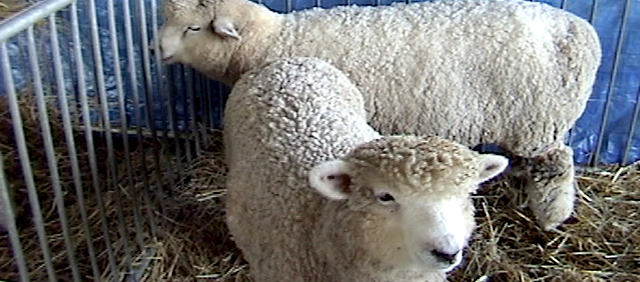Romney Sheep
Wool is probably the most popular fiber to spin, largely because of its versatility. It is also the easiest fiber for beginners to spin.
There are several different breeds of sheep, and each breed offers a different type of wool. It is well worth the time to learn the characteristics and purposes of the different types, in order to understand the types of yarn they will produce. Part of becoming an expert handspinner is being able to select the right fiber with a particular objective in mind and being able to meet the objective with success.
Wool comes in a variety of colors, lengths, curls, and textures. The main types of wool are: fine wools, medium / crossbred wools, and long wools.
Characteristics
• Natural, Animal Fiber
• Strong, durable
• Comfortable
• Flame resistant
• Versatile
• Elastic
• Warm
• Hand-washable or dry-clean
• Good insulator
• Wrinkle-resistant
• Dyes easily
• Blends extremely well with other fibers
Fine Wools
This wool group has an average of 50s-90s fiber diameter and is the softest of the other wool types. Fine wools spin well into fine yarns for knitting and crochet projects. They are the ideal wools for creating garments that can be worn against the skin, especially baby wearables. Fine wools blend well, and add elasticity and loft to other exotic fibers, such as, alpaca, angora, camel, silk, mohair, etc.
Merino
• Softest and fineness of all the wool types
• Fine crimp
• natural color is a bright white
• 2 1/2 – 4 inches staple length
• High grease content
• Good elasticity
• Excellent loft
• Good felting wool
• Works best if spun fine
• Spins woollen or worsted
Rambouillet
• 2 – 4 inches staple length
• More elasticity
• Most loft
• Works best if spun fine
• Spins woollen or worsted
Medium / Crossbred Wools
These wools are best for beginning handspinners to use. They are a good all purpose wool, which will spin into a medium-thick yarn, for knitted, crocheted, and woven, garments and fabrics.
Blue Faced Leicester, Border Leicester, Coopworth, Corriedale, Jacob, Romney
• Crossbred with Merino wool
• Moderately soft
• 3 – 5 inches staple length
• Easy to spin for beginning handspinners
• Good for felting
• Spin medium-thick yarn
• Spins woollen or worsted
Long Wools
These wools make strong, lustrous, worsted yarns for knitted and woven outer garments. The long staple of fiber may tangle during spinning, therefore, spinning from the fold is the best technique to use.
Cotswold, Wensleydale, Lincoln Longwool
• Medium to coarse texture
• Very strong, sturdy
• Wavy crimp
• Lustrous to semi-lustrous
• 5 – 8 1/2 inches staple length
• Easy to spin for beginning handspinners
• Resembles mohair
• Not well suited for felting
• Wear resistant
• Spin medium-thick yarn
• Best for worsted and semi-worsted yarn
• Blends well with other long staple fibers, like mohair
Down Wools
These are short staple wools; therefore, they are not a good choice for beginning handspinners. The diameter size of down wools ranges from soft to medium. The soft fleeces are used for apparel like socks and fine fabrics. The medium range fleeces are suitable for knitted and woven outerwear, longwearing garments, and blankets.
Dorset, Cheviot, Shetland, Suffolk
• Fine to medium texture
• Spiral crimp
• Lofty, spongy, crisp
• 2 – 3 1/2 inches staple length
• Very resilient
• Difficult to spin for beginning handspinners
• Lacks luster, chalky
• Good shape retention
• Not well suited for felting
• Wear resistant
• Spin medium-thick yarn
• Blends well with long wool fiber, to add resilience



